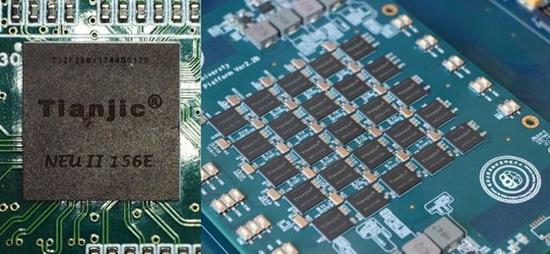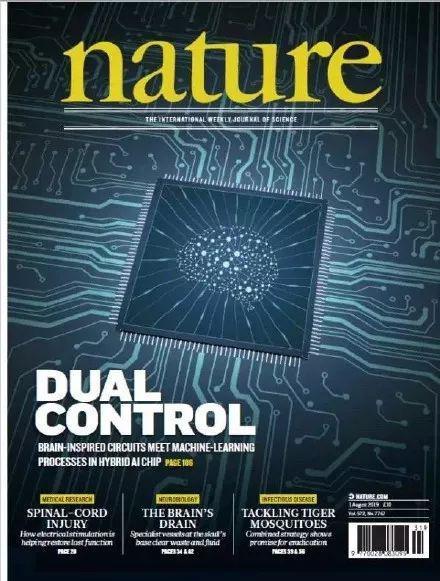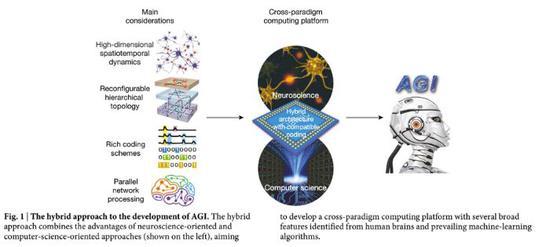來源:中國日報
原標題:清華大學的這輛自行車“成精”了!“天機”在全球頂尖期刊“泄露”
8月1日,清華大學研制出的一款自行車登上了最新一期全球頂尖期刊《自然》雜志(Nature)的封面!
跟CD君先來看看,自行車“成精”後的樣子。自我平衡↓↓
繞開障礙物↓↓
S型路線↓↓
向左轉↓↓
這輛無人自行車可實時感知周圍環境。它可以在跟隨前方試驗人員的同時自動進行避障操作。裝上芯片後,自行車可以根據語音指令、視覺感知的反饋産生實時信號,從而對電機進行控制,以達到保持平衡,改變行進狀態。
自行車爲什麽這麽“聽話”?吃了“仙丹”?別說,還真是。而且清華大學科學家研制的“仙丹”還是中國制造、全球首款。科學家團隊在自行車裏內部裝了一款名叫“天機”(Tianjic)的人工通用智能芯片。
這是一款中國自主研制的芯片,更是全球首款異構融合類腦芯片。8月1日,這款由清華大學類腦計算研究中心施路平教授帶領團隊研制出的芯片,登上了最新一期全球頂尖期刊《自然》雜志(Nature)的封面!
據悉,憑借這項研究,施路平團隊實現了中國在芯片和人工智能兩大領域Nature雜志論文零的突破。
Nature封面文章 | 中國團隊的“天機芯”架起了通用人工智能領域機器學習和神經科學的橋梁
該研究團隊的領導者是清華大學精密儀器系教授、類腦計算中心主任施路平,成員來自清華大學、北京靈汐科技、北京師範大學、新加坡理工大學和加州大學聖塔芭芭拉分校等科研機構。
七年,磨出一顆中國“芯”
曆時7年,施路平教授帶領的團隊,“打磨”出了中國人自己的通用人工智能(AGI)芯片——“天機芯”。
“天機芯”作爲一款新型計算機芯片,可用于實時物體檢測、跟蹤、語音識別、避障和平衡控制,是世界首款異構融合類腦芯片,也是世界上第一個既可支持脈沖神經網絡又可支持人工神經網路的人工智能芯片。
(施路平團隊發表的論文:《面向通用人工智能的混合天機芯片架構)
據Nature報道,當前,人工智能芯片發展有兩大主流方向,一種是以神經科學爲基礎,試圖建構模擬大腦的電路;另一種以計算機科學爲基礎,通過計算機來執行機器學習算法。
There are two main approaches to developing artificial general intelligence。 One is rooted in neuroscience, and attempts to construct circuits that closely mimic the brain。 The other is grounded in computer science, and uses computers to execute machine-learning algorithms。
然而,由于算法和模型的差別,當前人工智能芯片均只支持人工神經網絡或脈沖神經網絡,難以發揮計算機和神經科學兩個領域的交叉優勢。
但“天機芯”與以往的研究不同。
施路平教授表示,“我們做的是類腦(研究),是借鑒腦科學的基本原理,凝練出一些指導計算架構發展的新規律。”
在此基礎上,該團隊提出了符合腦科學基本規律的新型類腦計算架構——異構融合的天機類腦計算芯片架構,可通過資源複用,只需3%的額外面積開銷即可同時運行計算機科學和神經科學導向的絕大多數神經網絡模型,支持異構網絡的混合建模,形成時空域協調調度系統,發揮它們各自的優勢,既能降低能耗,提高速度,又能保持高准確度。
(“天機芯”綜合兩種運作方式)
也就是說,“天機芯”能將兩種運作方式集合在一個混合平台中。它具有有多個功能核心,可輕松實現重新配置,使其能同時運行機器學習算法和大多數神經網絡模型。
In this week‘s issue, Luping Shi and his colleagues reveal the Tianjic chip — an electronic chip that integrates the two approaches into one hybrid platform。 The Tianjic chip has multiple functional cores that are readily reconfigurable, enabling it to accommodate both machine-learning algorithms and brain-inspired circuits。
(“天機芯”的設計)
“這只是非常初步的一個研究,但這項研究或能爲面向人工通用智能計算平台的進一步發展起到促進作用。”施路平表示。
據一家專注于人工智能的網站Synced Review報道,“天機芯”關鍵創新之處在于其統一的功能核(FCore)。該功能核結合了人造神經網絡和生物網絡的基本構建基塊——軸突、突觸、樹突和胞體。
A key innovation from the research team is Tianjic‘s unified function core (FCore) which combines essential building blocks for both artificial neural networks and biologically networks — axon, synapse, dendrite and soma blocks。
“天機芯”采用28納米工藝制程打造,由156個功能核組成,包含約4萬個神經元和1千萬個突觸,其大小爲3.8×3.8平方毫米。
The 28-nm chip consists of 156 FCores, containing approximately 40,000 neurons and 10 million synapses in an area of 3.8×3.8 mm²。
研究團隊還展示了“天機芯” 與GPU相比較的優越性:“天機芯”的吞吐量比GPU高1.6-100倍,能效提高12-10000倍。
The research team also showcased the superior performance of Tianjic compared to GPU, where the new chip achieves 1.6–100 times better throughput and 12–10000 times better power efficiency。
(“天機芯”和測試板)
自行車雖小,“五髒”俱全
Nature在對該研究的介紹中肯定了“天機芯”應用于無人駕駛自行車的試驗。
研究人員將芯片安裝到無人自行車,來證明該芯片的強大功能和潛力。這款無人自行車能自我平衡,具有聲控功能,可探測並避開障礙物。這都是“天機”芯片能同時處理多種算法和模型的強大功能。
The researchers demonstrate the potential of this approach by incorporating one of their chips into a riderless autonomous bicycle, which can self-balance, is voice controllable and can detect and avoid obstacles, all as a result of the Tianjic chip‘s simultaneous processing of versatile algorithms and models。
Synced Review報道稱,這款搭載“天機芯”的無人自行車系統,還裝備了IMU傳感器、攝像頭、轉向電機、驅動電機、調速電機和電池等,使其能執行實時目標探測、跟蹤、語音命令識別、過障、自動避障、自平衡和自主決策等行爲。
Equipped with the Tianjic chip and IMU sensor, a camera, steering motor, driving motor, speed motor and battery, the bicycle was tasked with performing functions such as real-time object detection, tracking, voice-command recognition, riding over a speed bump, obstacle avoidance, balance control and decision making。
(無人自行車設計)
研究團隊開發了多種神經網絡來完成每項任務。這些模型經過預先訓練並編程到“天機芯”上,“天機芯”可並行處理這些模型,實現多種模型之間的無縫片上通信。
The research team developed a variety of neural networks (CNN, CANN, SNN and MLP networks) to enable each task。 The models were pretrained and programmed onto the Tianjic chip, which can process the models in parallel and enable seamless on-chip communication across different models。
施路平認爲,人工通用智能芯片能夠成功,多學科深度融合才是關鍵。
研究團隊介紹,他們希望“天機芯”可被用于無人駕駛汽車和智能機器人上。他們已經開始投入第二代芯片的研究,研發階段預計會在明年初結束。
The research team told Chinese media they expect the Tianjic chip to be deployed in autonomous vehicles and smart robots。 They have already started research on the next-generation chips and expect to close the R&D stage early next year。
加油!中國芯!












